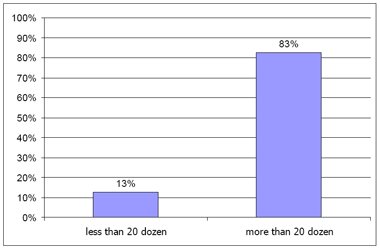- Print this page
- Download as PDF
- Share this page
The Egg Food Safety Scheme’s expected outcome is to improve egg handling and processing practices resulting in the production of safer and cleaner eggs by NSW egg businesses.
Its ultimate purpose is to reduce the incidence and potential for foodborne illness from eggs and egg products produced in NSW. It was implemented in NSW from 18 June 2010.
Implementation of the Scheme and later evaluation processes have resulted in:
2010: industry benchmark survey
Background
The NSW Food Authority surveyed NSW egg businesses to help establish pre-regulation industry benchmarks in 2010.
The aims of the survey were to:
- gather industry profile information on the various activities undertaken by egg businesses to inform the regulatory development process
- assess industry preparedness before introduction of the Scheme and identify ways the Authority could best provide businesses with information about the Scheme
- refine and update the Food Authority’s database of potential licence holders.
The self-assessment survey was sent to more than 300 egg businesses in NSW.
Almost 40 egg businesses completed the survey by online or paper-based questionnaire.
Results
The survey found that:
- free-range was the most common production system for survey participants
- at least 1/3 of survey businesses indicated they needed to implement a food safety program in order to comply with the new requirements
- 3/4 of the businesses surveyed requested assistance when learning about the new requirements.
Survey findings informed the regulatory development process and identified ways the Food Authority could best assist egg businesses implement the new requirements.

NSW egg producers/processors' scale of operation
(dozen eggs per week)
- Benchmark survey of NSW egg businesses, February 2011 (pdf 138KB, 14pp)
2011-12: baseline evaluation, first regulatory visit
Background
The Food Authority undertook an evaluation in 2011-12 to assess implementation of the Scheme regulations and establish industry benchmarks for future impact assessments.
The evaluation:
- examined the extent to which the regulation has been implemented as planned
- sets baselines to help determine in the future:
- the extent to which the intended outcomes have been achieved
- ways in which the regulation can be fine-tuned.
4 projects were undertaken:
- industry profile and compliance data was collected from about 140 food businesses
- environmental samples from 49 farms were collected and analysed for microbiology
- initial inspection and compliance data was analysed
- the Food Authority’s foodborne illness data was reviewed.
Results
3 reports document the baseline evaluation of the NSW Egg Food Safety Scheme.
A summary of the data and overall findings from the 4 projects are set out in Results Summary Report, January 2013 (pdf 343KB, 17pp). These include:
- an assessment of the Food Authority’s implementation of the regulation, against an implementation scorecard
- a profile of the NSW egg production and processing industry covering industry location, size and production systems (cage, barn and free range)
- a summary of outcomes of egg businesses’ first regulatory audit/inspection compliance rates
- industry benchmarks for selected food safety practices (managing system inputs of stock feed, drinking water) and biosecurity; cracked egg handling; egg cleaning; egg labelling and traceability
- baseline microbiological profile for farms, system inputs and laying environments in respect of Salmonella types
- a review of egg-related outbreaks of foodborne illness from 2009 to 2012.
Further detail is provided in:
- Survey of NSW egg businesses – industry profile and observed practices, January 2013 (pdf 450KB, 27pp).
- Microbiological survey of egg farms in NSW, January 2013 (pdf 515KB, 34pp).
After the 2011-12 evaluation, 4 recommendations were put forward for consideration where the Food Authority focuses on:
- audit and reporting consistency
- continues building its knowledge of the egg industry in NSW
- reviews industry assistance materials
- communicates a through-chain Salmonella risk management strategy for eggs.
